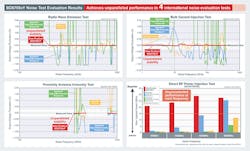Op Amps Shrug Off Automotive, Industrial, Other EMI
This article is part of the TechXchange: Delving into EMI, EMC and Noise
Along with temperature extremes, electromagnetic interference (EMI) is a pervasive issue in automotive, industrial, and even medical environments as it can stimulate noise-induced errors, disrupt circuit performance, and even induce gross malfunction. While there are techniques to attenuate EMI and mitigate its effects, these usually require addition of components such as shielding, ferrite beads, filtering, bypassing, and more, all of which raise cost and real-estate requirements as well as design and qualification uncertainty.
Recognizing this situation, ROHM introduced its EMARMOUR series in 2017, which provides superior noise immunity by combining a vertically integrated production system with proprietary analog design technology. Components in this series are designed to prevent malfunctions due to noise and do so without the need for special EMI-mitigation measures. The goal is to simplify up-front modeling and design, and reduce debug time and time to market.
The latest entries in this family are the BD8758xY series of rail-to-rail input/output high-speed CMOS op amps with enhanced EMI immunity. These op amps target applications requiring high-speed sensing in harsh environments, such as vehicle engine control units (ECUs) and anomaly detection systems for factory automation equipment. The single-channel BD87581YG-C and dual-channel BD87582YFVM-C devices in the series (both AEC-Q100 Qualified - Grade 1) are designed to prevent malfunctions due to noise without the need for special mitigation techniques.
This claim is backed by quantitative tests including four international noise evaluation tests: ISO 11452-2 Radio Wave Emission Test, ISO 11452-4 Bulk Current Injection Test, ISO 11452-9 Proximity Antenna Immunity Test, and IEC 62132-4 Direct RF Power Injection Test (Fig. 1). For example, in ISO 11452-2 radio wave emission testing, the output voltage of the BD8758xY series fluctuates by less than ±10 mV, while standard products vary by more than ±300 mV in all frequency bands. This minimal disturbance can eliminate the need for EMI “countermeasures” at each frequency of concern, a step that can include up to 10 RC-filter components for a two-channel op amp.
The BD87581YG-C (SSOP-5 package) and BD87582YFVM-C (MSOP-8 package) op amps target automotive requirements such as sensor amplifiers, ECUs, electric power steering, and anti-lock braking systems due to their high slew rate and low input bias current. They also can be used for industrial applications. The specifications for the single- and two-channel devices are fairly similar (Fig. 2), but other modest differences in top- and second-tier specifications are called out in the datasheets.
Today’s design begins with detailed simulation—usually Spice-based—and the fidelity of the model is obviously vital to assuring meaningful simulation results. ROHM’s new, high-accuracy simulation model (dubbed “ROHM Real Model”) uses model-based technology to faithfully reproduce the electrical and temperature characteristics of the actual IC, thus minimizing rework after prototyping. The models yield a very close match between the IC and simulation values for reliable verification and more efficient application development (Fig. 3).
In addition to the datasheet for the new pair, the four-minute video below discusses the attributes of these op amps, focusing on EMARMOUR EMI-resistant technology and ISO tests, as well as the Spice models.
The op amps are priced at under $1 in small quantities.
About the Author

Bill Schweber
Contributing Editor
Bill Schweber is an electronics engineer who has written three textbooks on electronic communications systems, as well as hundreds of technical articles, opinion columns, and product features. In past roles, he worked as a technical website manager for multiple topic-specific sites for EE Times, as well as both the Executive Editor and Analog Editor at EDN.
At Analog Devices Inc., Bill was in marketing communications (public relations). As a result, he has been on both sides of the technical PR function, presenting company products, stories, and messages to the media and also as the recipient of these.
Prior to the MarCom role at Analog, Bill was associate editor of their respected technical journal and worked in their product marketing and applications engineering groups. Before those roles, he was at Instron Corp., doing hands-on analog- and power-circuit design and systems integration for materials-testing machine controls.
Bill has an MSEE (Univ. of Mass) and BSEE (Columbia Univ.), is a Registered Professional Engineer, and holds an Advanced Class amateur radio license. He has also planned, written, and presented online courses on a variety of engineering topics, including MOSFET basics, ADC selection, and driving LEDs.



